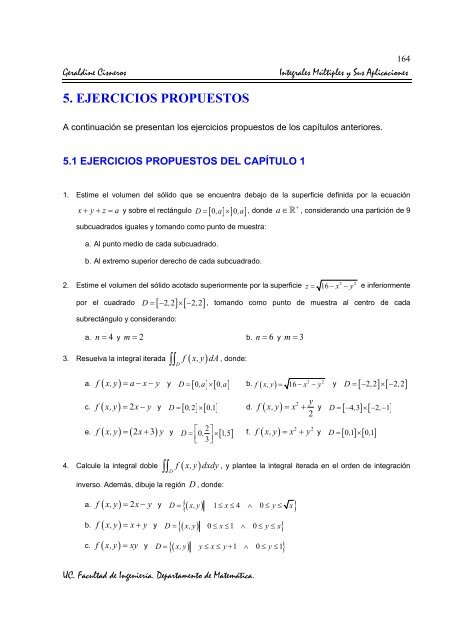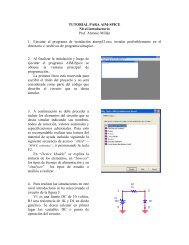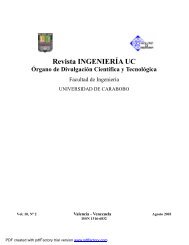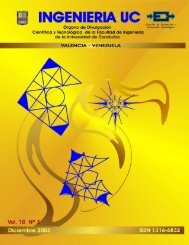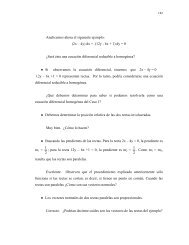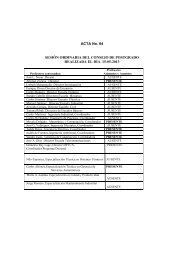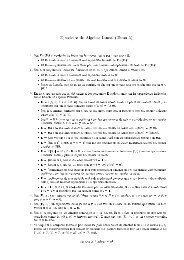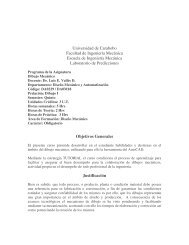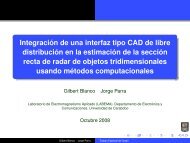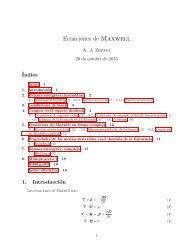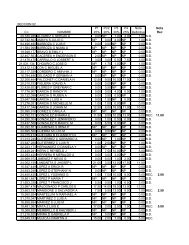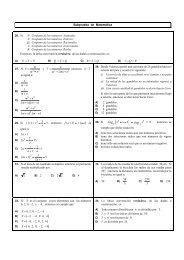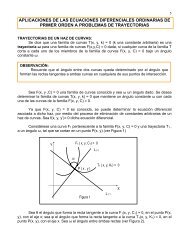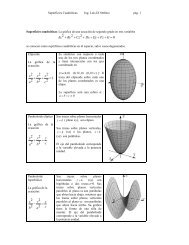descargar aquà - Facultad de IngenierÃa
descargar aquà - Facultad de IngenierÃa
descargar aquà - Facultad de IngenierÃa
Create successful ePaper yourself
Turn your PDF publications into a flip-book with our unique Google optimized e-Paper software.
Geraldine Cisneros164Integrales Múltiples y Sus Aplicaciones5. EJERCICIOS PROPUESTOSA continuación se presentan los ejercicios propuestos <strong>de</strong> los capítulos anteriores.5.1 EJERCICIOS PROPUESTOS DEL CAPÍTULO 11. Estime el volumen <strong>de</strong>l sólido que se encuentra <strong>de</strong>bajo <strong>de</strong> la superficie <strong>de</strong>finida por la ecuaciónx y z a+ + = y sobre el rectángulo D [ 0,a ] [ 0,a]subcuadrados iguales y tomando como punto <strong>de</strong> muestra:a. Al punto medio <strong>de</strong> cada subcuadrado.b. Al extremo superior <strong>de</strong>recho <strong>de</strong> cada subcuadrado.+= × , don<strong>de</strong> a ∈ , consi<strong>de</strong>rando una partición <strong>de</strong> 92 22. Estime el volumen <strong>de</strong>l sólido acotado superiormente por la superficie z = 16 −x − y e inferiormentepor el cuadrado D [ 22 , ] [ 22 , ]subrectángulo y consi<strong>de</strong>rando:= − × − , tomando como punto <strong>de</strong> muestra al centro <strong>de</strong> cadaa. n = 4 y m = 2b. n = 6 y m = 33. Resuelva la integral iterada ( )UC. <strong>Facultad</strong> <strong>de</strong> Ingeniería. Departamento <strong>de</strong> Matemática.∫∫D fx,y dA , don<strong>de</strong>:a. f ( x,y)= a −x − y y D [ 0,a ] [ 0,a]2 2= × b. f ( x,y) = 16 −x − y y D = [ − 22 , ] × [ − 22 , ]2c. f ( x,y) = 2x− y y D = [ 02 , ] × [ 01 , ] d. f ( x,y) = x + y D = [ − 43 , ] × [ −2,− 1]e. f ( x,y) = ( 2x + 3)y y D ⎡ 0 2 ⎤= , × [ 15 , ]∫∫4. Calcule la integral doble ( )D f⎢⎣3⎥⎦inverso. A<strong>de</strong>más, dibuje la región D , don<strong>de</strong>:a. f ( x,y) = 2x− y y ( )b. f ( x,y)x y= + y ( )y22 2f. f ( x,y) = x + y y D = [ 01 , ] × [ 01 , ]x,y dxdy , y plantee la integral iterada en el or<strong>de</strong>n <strong>de</strong> integración= { 1≤ ≤4 ∧ 0≤ ≤ }{ 0 1 0 }D x,y x y xD = x,y ≤ x ≤ ∧ ≤ y ≤ xc. f ( x,y)= xy y D = {( x,y)y≤ x≤ y+ 1 ∧ 0≤ y≤1}
Geraldine Cisneros165Integrales Múltiples y Sus Aplicaciones⎧x ⎫D = ⎨ x,y ≤ x≤ ∧ ≤ y≤x⎬⎩2 ⎭d. f ( x,y) = x+ ( 2y+ 3) 3y ( ) 0 4 4{ }32e. f ( x,y) = 2 x − y y4D = ( x,y)0≤ x ≤1∧ x ≤ y ≤ xxyf. f ( x,y) = e −2 2y D = {( x,y)x≥ 0 ∧ y≥ 0 ∧ x + y ≤ 1 }2 22 2 2 2g. f ( x,y) = x + y y D = {( x,y)y≥ 0 ∧ x + y ≥ 1 ∧ x + y − 2 x≤0 }2 32h. f ( x,y) = x + 2yy D = {( x,y)y ≤ 4 x −x ∧ y ≥ 0 ∧ y ≥ 6 − 3 x}2i. f ( x,y)= x + y y D = {( x,y)y≤ x ∧ y≥ x − 4}2j f ( x,y)= xey2y D = {( x,y)x≥ 0 ∧ x ≤ y≤9 }h.3 2f ( x,y) = x+ y+ 2 y D = {( x,y)y≤ 3 −x − 2 x ∧ y≥x}5. Calcule la integral doble⎛4 13 , ⎞⎜ ⎟⎝ 3⎠y ( 0,− 1).∫∫, siendo D el paralelogramo <strong>de</strong> vértices: ⎛ 2 1⎜−, −D xdxdy⎝⎞⎟, ⎛ 2 13 3⎠3 , ⎞,⎜ ⎟⎝ 3⎠6. Calcule la integral doblelas rectas y∫∫D2xx + y2 2= x, y =− x y x = 1 .dxdy , siendo D el triángulo cuyos lados están <strong>de</strong>finidos por7. Calcule la integral doble ( − 2 2) ( + )( 0,π ), ( 2 π , π ) y ( ,2 )π π .∫∫Dx y sen x y dxdy , siendo D el triángulo cuyos vértices son:UC. <strong>Facultad</strong> <strong>de</strong> Ingeniería. Departamento <strong>de</strong> Matemática.
Geraldine Cisneros166Integrales Múltiples y Sus Aplicaciones5.2 EJERCICIOS PROPUESTOS DEL CAPÍTULO 2−∫∫∫don<strong>de</strong> B [ 02 , ] [ 01 , ] [ 13 , ]x + y + z + 2 dxdydzB1. Calcule ( ) 1 2= × × − .2. Calcule∫∫∫don<strong>de</strong> ⎨( )B zdxdydz2 2 2⎧x y z ⎫B= x,y,z x≥0 ∧ y≥0 ∧ z≥0 ∧ + + ≤12 2 2 ⎬ .⎩a b c ⎭3. Calcule ( +2 2∫∫∫ ) don<strong>de</strong> ( ) ( )B x y dxdydz{ 4 16 }B= x,y,z x + y ≤ z≤ .22 2 24. Calcule∫∫∫ ( 3x − y ) dxdydz don<strong>de</strong> B {( x,y,z)y z 4 x y }B= ≤ ≤ − − .5. Calcule2 2 2∫∫∫don<strong>de</strong> B {( x,y,z)x y 2 x 0 z y }B dxdydz= + ≤ ∧ ≤ ≤ .6. CalculeBx+yz dxdydz2∫∫∫don<strong>de</strong> B es el sólido limitado por las superficies: y x{ }2 2 2y = 2 x , B= ( x,y,z)x + y ≤ 2 x ∧ 0 ≤ z≤ y .= ,7. Calcule2z = 8x.∫∫∫don<strong>de</strong> B es el sólido limitado por las superficies: y2 22 3x yz dxdydzB= x yUC. <strong>Facultad</strong> <strong>de</strong> Ingeniería. Departamento <strong>de</strong> Matemática.
Geraldine Cisneros167Integrales Múltiples y Sus Aplicaciones5.3 EJERCICIOS PROPUESTOS DEL CAPÍTULO 31. Calcule el área entre las circunferenciasC:x + y − y= y2 214 0C :x y y2 22+ − 2 = 02. Plantee el volumen <strong>de</strong>l sólido ( )empleando integrales dobles y triples.2 2 2⎧x y z ⎫B= ⎨ x,y,z x≥0 ∧ y≥0 ∧ z ≥0 ∧ + + ≤12 2 2 ⎬ ,⎩a b c ⎭3. Calcule el volumen <strong>de</strong>l tetraedro acotado por los planos: x = 0 , y = 0 , z = 4 y z = x+ 2y.4. Para el sólido B . Calcule: masa, momentos estáticos, centro <strong>de</strong> masa y momentos <strong>de</strong> inercia,siendo ( ){ 0 0 4 2 }B= x,y,z x≥ ∧ y≥ ∧ z≤ ∧ z≥ x+ y .M= + ,32 25. Demuestra que los momentos estáticos para el sólido B son: Mx ( b c )MMya c32 22 2= ( + ) y Mz ( a b )como: ( )M= + , don<strong>de</strong> M es la masa <strong>de</strong>l sólido y B está <strong>de</strong>finido3{ 0 0 0 }B= x,y,z ≤ x≤a ∧ ≤ y≤b ∧ ≤ z≤ c .6. Plantee el volumen <strong>de</strong>l sólido acotado por el cilindro2 2x y 2x+ = , sobre el plano z = 0 y bajo elparaboloi<strong>de</strong>2 2z = x + y .7. Calcule el centro <strong>de</strong> masa y los momentos <strong>de</strong> inercia <strong>de</strong>l sólido <strong>de</strong>finido como:2 2{( ) 2 02}B= x,y,z x + y ≤ x ∧ ≤ z≤ y .UC. <strong>Facultad</strong> <strong>de</strong> Ingeniería. Departamento <strong>de</strong> Matemática.
Geraldine Cisneros168Integrales Múltiples y Sus Aplicaciones5.4 EJERCICIOS PROPUESTOS DEL CAPÍTULO 41. Calcule la integral1∫∫D2 2( ) 3 21+ x + yempleando un cambio <strong>de</strong> variable a<strong>de</strong>cuado.dxdydon<strong>de</strong> ( ){ 0 1 0 }D= x,y ≤ x ≤ ∧ ≤ y ≤ x ,2. Calcule la integral doble⎛4 13 , ⎞⎜ ⎟⎝ 3⎠∫∫, siendo D el paralelogramo <strong>de</strong> vértices: ⎛ 2 1⎜−, −D xdxdy⎝⎞⎟, ⎛ 2 13 3⎠3 , ⎞,⎜ ⎟⎝ 3⎠y ( 0,− 1), empleando un cambio <strong>de</strong> variable, <strong>de</strong> manera que los nuevos vértices sean: ( 00)( 10 , ), ( 11 , ) y ( 01 , ), ,3. Calcule la integralxx + y2∫∫ dxdy don<strong>de</strong>D 2 2( ){ 0 1 2 2 2}D= x,y ≤ x≤ ∧ x ≤ y ≤ − x ,empleando el cambio <strong>de</strong> variable: x = v− u y y = u+ v.4. Calcule el volumen <strong>de</strong>l sólido acotado por el cilindro+ = 2 , sobre el plano z = 0 y bajo el2 2x y xparaboloi<strong>de</strong>2 2z = x + y , empleando un cambio <strong>de</strong> variable a<strong>de</strong>cuado.5. Dibuje el sólido acotado por la superficie cerrada r = 1− cosφ , <strong>de</strong>finida en coor<strong>de</strong>nadas esféricas.A<strong>de</strong>más, calcule el volumen <strong>de</strong> dicho sólido, empleando coor<strong>de</strong>nadas esféricas.6. Determine el centro <strong>de</strong> masa para el sólido limitado por las superficies:2 2 2z = x + y ,2 2 2x + y + z = 2 , don<strong>de</strong> z ≥ 0 y la <strong>de</strong>nsidad es proporcional a la distancia en cada punto,empleando un cambio <strong>de</strong> variable a<strong>de</strong>cuado.7. Determine momento <strong>de</strong> inercia <strong>de</strong> un sólido acotado por la superficie x 2 + y 2 + z2 = 25 , cuya2 2 2− ( x + y + z )ρ x,y,z = e , empleando un cambio <strong>de</strong> variable a<strong>de</strong>cuado.<strong>de</strong>nsidad viene dada ( )8. Calcule el volumen <strong>de</strong>l sólido ( )cilíndricas.2 2{ 2 02}B= x,y,z x + y ≤ x ∧ ≤ z≤ y , empleando coor<strong>de</strong>nadasUC. <strong>Facultad</strong> <strong>de</strong> Ingeniería. Departamento <strong>de</strong> Matemática.


